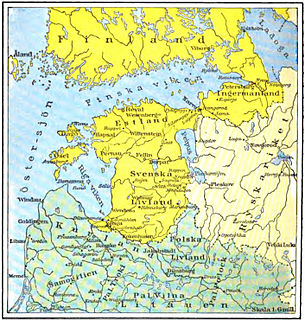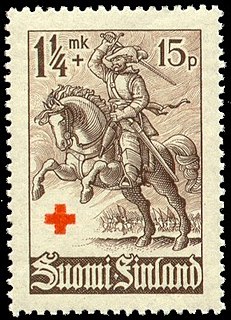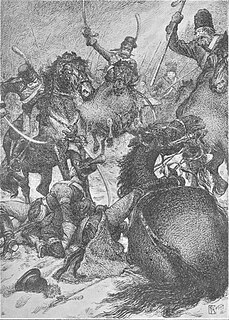
The counties of Sweden are the top-level geographic subdivisions of Sweden. Sweden is today divided into 21 counties; however, the number of counties has varied over time, due to territorial gains/losses and to divisions and/or mergers of existing counties. This level of administrative unit was first established in the 1634 Instrument of Government on Lord Chancellor Count Axel Oxenstierna's initiative, and superseded the historical provinces of Sweden in order to introduce a more efficient administration of the realm. At that time, they were what the translation of län into English literally means: fiefdoms. The county borders often follow the provincial borders, but the Crown often chose to make slight relocations to suit its purposes.

The Swedish Army is the land force of the Swedish Armed Forces.

Kexholm County was a county of the Swedish Empire from 1634 to 1721, when the southern part was ceded to the Russian Empire in the Treaty of Nystad. The capital of the county was Kexholm, which today is Priozersk.
The Crown Prince's Hussar Regiment, designated K 7, was a Swedish Army cavalry regiment located in the province of Scania that traced its origins back to the 18th century. It had a number of names over its history, most famously Mörner's Hussar Regiment during the Napoleonic Wars. It was disbanded in 1927.

Hakkapeliitta is a historiographical term used for a Finnish light cavalryman in the service of King Gustavus Adolphus of Sweden during the Thirty Years' War. Hakkapeliitta is a 19th-century Finnish modification of a contemporary name given by foreigners in the Holy Roman Empire and variously spelled as Hackapelit, Hackapelite, Hackapell, Haccapelit, or Haccapelite. These terms were based on a Finnish battle cry hakkaa päälle, commonly translated as "Cut them down!"
Swedish dialects are the various forms of the Swedish language, particularly those that differ considerably from Standard Swedish.

The Life Regiment Hussars is one of Europe's most victorious military regiments and one of the world's oldest regiments still active. The regiment descends directly from units set up by King Gustav I of Sweden in 1536, when Sweden set up a draft of horses and men north and south of Stockholm. The regiment was very active in the 1600s and 1700s and helped win several key battles for Sweden on the European continent. Today, the regiment plays a central role in the Swedish Armed Forces and is the most active regiment in Swedish military international engagements.
The Nyland and Tavastehus County Cavalry Regiment was a Swedish Army cavalry regiment located in the county of Nyland and Tavastehus that traced its origins back to the 17th Century. It was split in 1791.

The Battle of Pyhäjoki was a retreating action fought on 16 April 1808, at Pyhäjoki in Northern Ostrobothnia during the Russian–Swedish war of 1808–09. The winter made the operations more difficult and the battle of Pyhäjoki became one of the first skirmishes to be fought after the Swedish retreat stopped. The Russian army had been following the Swedish army to the north. At the same time, they had left large portions of Finland to be occupied by the Russians. Yakov Petrovich Kulnev led a vanguard of 1,300 men — his army counted 4,000 men in total — and caught up with the rearguard of the retreating Swedish main army at the village of Ypperi. Skirmishes occurred all the way to Pyhäjoki, where the Swedes made a brief stand, before Wilhelm Mauritz Klingspor gave orders to von Döbeln and Gripenberg to continue the retreat to follow the original strategic plan. The Swedes had checked Kulnev's attack with about 2,000–2,500 men, however, as the Swedes fought a retreating battle, only one battalion at the time could go up against the Russians for most of the fighting. They had lost 183 men in killed, wounded and captured. Kulnev had lost 71 men at Pyhäjoki alone but probably around double that number when applying the losses from the fighting at Ypperi towards Pyhäjoki.
The Scanian Hussar Regiment was a Swedish Army cavalry unit which operated in various forms the years 1658–1709 and 1709–1927.
The following units fought in the Battle of Lesnaya on October 9, 1708 during the Great Northern War.
The Defence Act of 2000 was a defence act passed by the Swedish Riksdag on 30 March 2000, and the largest reorganisation of the Swedish Armed Forces since the Defence Act of 1925. The act was a continuation of the policies set in motion by the Defence Act of 1996: shifting the military's focus from the defence of Swedish territory to a more flexible "operational defence* for smaller-scale peacekeeping operations in foreign nations. Many military formations were disbanded as a result.
The Defence Act of 1925 was a defence act passed by the Swedish Riksdag on 26 May 1925 and came into force on 1 January 1928. The Act specified how the Swedish Armed Forces would operate during the coming years. The Act resulted in a policy of disarmament. The Act would remain effective until the Defence Act of 1936.

The Life Regiment Dragoons, designated K 2, was a Swedish Army cavalry regiment that was active in various forms 1791–1927. The unit was based in the Stockholm Garrison in Stockholm and belonged to the King's Life and Household Troops until 1974.
North Scanian Infantry Regiment, designation I 6, was a Swedish Army infantry regiment that operated from 1812 to 1963. The unit was based in the Kristianstad Garrison in Kristianstad. In 1963 the regiment was transferred to the Swedish Armoured Troops under the name of North Scanian Regiment.
Life Guards of Horse was a Swedish Army cavalry regiment, first raised in 1770. It saw service for two centuries, before being amalgamated with the Life Regiment Dragoons to form the Life Regiment of Horse in 1928.

The Scanian Dragoon Regiment, designated P 2 and P 2/Fo 14, was an armored regiment of the Swedish Army with its roots in the 17th century. The unit was first based in Helsingborg and later in Hässleholm.
Life Regiment of Horse was a Swedish Army cavalry based in Stockholm. In was formed in 1928 through a merger of the Life Guards of Horse and the Life Regiment Dragoons. The unit was disbanded in 1949 and was amalgamated into the Life Guards Squadron.








